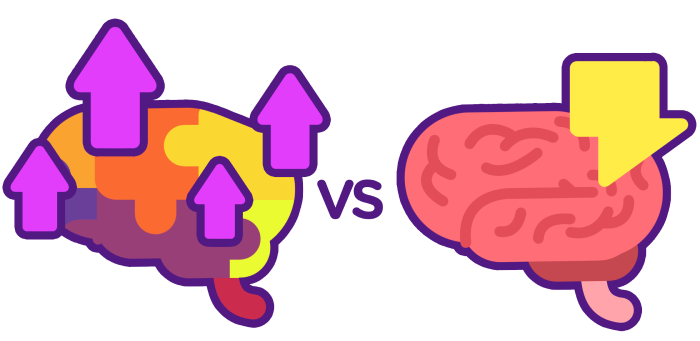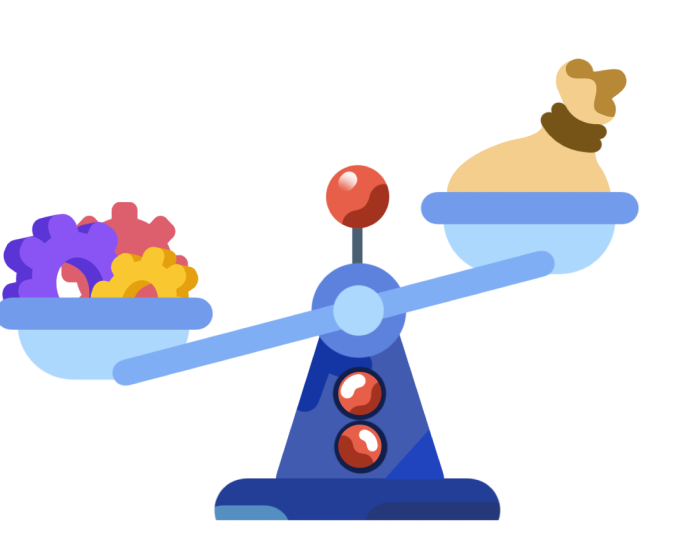A colaboração em nível de equipe já se tornou um elemento básico da experiência de trabalho contemporânea e, com o avanço da tecnologia e a onda cada vez maior de trabalho remoto, ela deve assumir uma importância ainda maior nos próximos anos.
No entanto, a colaboração não é igualmente adequada para todas as equipes e todos os cenários profissionais. Há uma série de situações profissionais em que uma abordagem colaborativa pode gerar mais obstáculos e desafios e produzir resultados menores do que uma abordagem diferente para a distribuição do trabalho. Além disso, a dinâmica interpessoal da equipe e outros fatores criam riscos adicionais para o sucesso de um relacionamento colaborativo.
Como já escrevemos extensivamente sobre os benefícios da colaboração, usaremos as linhas a seguir para destacar uma série de situações profissionais nas quais a colaboração promete uma vantagem significativa, mas também traz desvantagens potenciais. Examinaremos ambos os lados da moeda para comparar os riscos e os benefícios potenciais e tentar identificar os fatores que impactam significativamente os resultados.
A colaboração é uma forma de interação humana. Como em qualquer outra interação, sua qualidade e seu sucesso são altamente baseados nas características individuais dos colaboradores. Dependendo da combinação de membros da equipe e suas características individuais (habilidades de comunicação, habilidades interpessoais, motivações, etc.), diferentes cenários de colaboração podem fornecer benefícios para a organização ou criar obstáculos e desafios prejudiciais às suas operações gerais. Vamos dar uma olhada nesses cenários e ver como e por que eles podem resultar em resultados totalmente diferentes.
Distribuição de papéis vs. ambiguidade de funções
Um dos principais benefícios desejados da colaboração é a distribuição ideal de funções na equipe. Idealmente, as funções e responsabilidades individuais dos membros da equipe serão distribuídas de uma maneira que maximize suas habilidades individuais e as combine para aumentar a eficiência, tanto em termos de tempo quanto de produção.
Na prática, esse não é necessariamente o caso. Com a natureza dinâmica e frequentemente fluente do trabalho compartilhado, uma abordagem colaborativa pode, às vezes, criar ambiguidade e incerteza em relação às funções e responsabilidades individuais, dificultando significativamente o processo colaborativo. As consequências dessa ambiguidade podem ser diferentes: alguns membros da equipe podem supor falsamente que a responsabilidade está em outro lugar, outros membros da equipe podem assumir um falso papel de autoridade ou liderança, enquanto outros podem começar a sentir que nem todos os seus colegas estão contribuindo igualmente. Essas situações podem levar a conflitos, apatia e diminuição da produtividade.
Melhores práticas: Ambiguidade e incerteza em relação às funções da equipe podem ser evitadas definindo e comunicando claramente as funções desde o início, aumentando a transparência do trabalho de todos, bem como definindo claramente tarefas, prazos e expectativas, monitorando o progresso e fornecendo feedback para garantir que todos estejam em sintonia e fazendo sua parte.
Responsabilidade compartilhada vs. nenhuma responsabilidade
No melhor cenário, a colaboração leva a um senso compartilhado de responsabilidade pelo sucesso do processo, no qual todos os membros da equipe estão cientes da importância de suas contribuições para o resultado do projeto e investidos na realização dos objetivos da equipe. Isso leva a um senso de propósito compartilhado e, consequentemente, a maiores níveis de motivação e engajamento entre os membros da equipe.
Na realidade, a mudança de responsabilidade de um nível individual para uma equipe pode confundir os limites da responsabilidade individual e dificultar o reconhecimento de contribuições individuais. Isso é igualmente importante para resultados positivos, onde pode ser difícil identificar as contribuições mais impactantes ("dar crédito a quem o crédito é devido"), bem como resultados negativos, onde precisamos entender o que deu errado. Os cenários negativos de responsabilidade confusa incluem membros da equipe evitando suas responsabilidades individuais e "se escondendo" atrás da equipe, uma sensação de frustração e desmotivação por ter seu trabalho não reconhecido ou sentir que os outros não estão igualmente comprometidos, uma falta de confiança entre os membros da equipe, bem como uma capacidade reduzida de recompensar adequadamente as contribuições positivas e criticar e corrigir as negativas.
Melhores práticas: Evitar a falta de responsabilidade em uma equipe começa pela comunicação adequada da visão e dos objetivos da equipe, com um entendimento completo de como os esforços individuais contribuem para sua realização. Embora a colaboração seja um esforço de equipe, todos os participantes devem executar suas tarefas individuais, e é essencial que o trabalho individual seja visível e transparente para que os membros da equipe possam manter uns aos outros responsáveis.
Criatividade aumentada vs. muitas sessões de geração de ideias

Um dos maiores benefícios da colaboração em equipes multidisciplinares é o aumento da criatividade e da capacidade de resolução de problemas decorrentes de diferentes conjuntos de habilidades, perspectivas e experiências profissionais dos membros da equipe. Essa diversidade profissional pode estimular a inovação, aumentar a capacidade da equipe de encontrar respostas para desafios difíceis e imprevistos e melhorar sua flexibilidade em responder a circunstâncias em mudança.
Por outro lado, o trabalho pode facilmente ficar atolado por sessões de geração de ideias em excesso, reuniões e debates demorados, retardando assim o processo colaborativo e desviando das responsabilidades regulares e do trabalho "real". O processo pode ser ainda mais demorado e complicado por meio de perspectivas conflitantes e falta de resolução.
Melhores práticas: a ineficiência causada por excessos pode ser minimizada ou evitada mantendo o tempo alocado sob controle e reservando intervalos de tempo específicos para consulta, tentando atingir o equilíbrio ideal entre consultas e trabalho ativo. Além disso, as equipes podem tomar medidas para aumentar a eficiência de suas reuniões e sessões de ideias, estreitando o foco das reuniões e insistindo em conclusões acionáveis.
Tomada de decisão equilibrada vs. pensamento de grupo
O trabalho colaborativo geralmente implica um estilo de liderança mais distribuído e um processo de tomada de decisão mais inclusivo. Se os membros da equipe têm voz na definição do curso futuro do trabalho, eles estão fadados a se envolver mais nele e a se motivar mais para atingir os objetivos compartilhados. As decisões são tomadas pelo consenso de múltiplas perspectivas, fornecendo assim uma base mais abrangente e mais bem informada para escolher o melhor caminho a seguir.
A desvantagem de um processo de tomada de decisão inclusivo é que ele é amplamente moldado pela dinâmica específica do grupo presente em uma equipe. Consequentemente, o processo pode facilmente escorregar para padrões de comportamento menos desejáveis. Alguns exemplos desses padrões são o pensamento de grupo, onde as opiniões de outros membros da equipe são influenciadas por colegas mais autoritários e perspectivas alternativas são rejeitadas ou ignoradas, conflitos de opiniões divergentes onde as divergências não podem ser facilmente resolvidas de forma positiva, ou indecisão que pode desperdiçar tempo e deteriorar a química da equipe.
Melhores práticas: Um processo de tomada de decisão coletiva saudável e eficaz é baseado na existência de um ambiente seguro e inclusivo que incentive a participação e respeite a contribuição de todos. É essencial que todas as vozes sejam tratadas igualmente. Além disso, as equipes devem instituir mecanismos claros e justos para resolver desacordos e tomar decisões em situações de impasse, seja por meio da autoridade de um líder de equipe, votação ou um modelo diferente.
Produtos aprimorados vs. custos de colaboração

Idealmente, a colaboração combina conjuntos de habilidades divergentes para produzir resultados maiores do que a soma de suas partes. A natureza multidisciplinar das equipes permite que elas enfrentem e superem desafios que não poderiam ser enfrentados por um conjunto de habilidades mais restrito e uniforme. Além disso, relacionamentos interpessoais fortes e uma visão compartilhada resultam em maior motivação e maior produtividade.
Por outro lado, toda colaboração vem com seus custos específicos expressos na forma de tempo. De reuniões e comunicação escrita a trabalho adicional e todos os outros aspectos do trabalho em conjunto, a colaboração consome tempo que pode ser gasto em trabalho independente e autônomo. Se uma colaboração atrapalha o trabalho regular dos participantes e impacta seu desempenho, pode desacelerar as operações gerais de uma organização.
Melhores práticas: O custo da colaboração deve ser avaliado e comparado a outros modelos de organização do trabalho antes mesmo de começar. A avaliação adequada e objetiva dos recursos da equipe é um pré-requisito crítico para escolher corretamente se deve colaborar ou não. Os resultados da colaboração devem ser monitorados e avaliados regularmente para determinar sua eficácia e fazer quaisquer ajustes necessários.
Moral aprimorado vs. potencial para conflito
Por design, um ambiente colaborativo aproxima as pessoas por meio de uma visão e responsabilidade compartilhada, e um investimento compartilhado no resultado do trabalho coletivo. Uma colaboração harmoniosa cria uma perspectiva positiva sobre o ambiente de trabalho da equipe, fortalece relacionamentos pessoais e gera confiança entre os membros da equipe, o que resulta em uma moral elevada e um senso mais forte de pertencimento.
Como alternativa, as colaborações carregam um risco de conflito entre os membros da equipe, seja por estilos divergentes de trabalho, competição doentia ou simplesmente traços de caráter opostos. Há uma grande diferença, mas também uma linha tênue entre desacordos profissionais e conflitos pessoais, e se os primeiros se transformarem nos últimos, isso pode ter um impacto verdadeiramente prejudicial na moral da equipe e, em última análise, na produtividade da equipe.
Melhores práticas: Criar um ambiente de trabalho harmonioso que impacte positivamente a equipe não é um processo simples e unilateral, mas um esforço abrangente que envolve praticamente todos os aspectos das atividades de uma organização. Seu pré-requisito principal é uma comunicação saudável e aberta que respeite os valores e perspectivas únicas de cada um, um ambiente seguro onde as opiniões podem ser trocadas livre e construtivamente. No entanto, conflitos podem surgir mesmo nos ambientes mais positivos, e é importante que eles sejam abordados rápida e adequadamente antes que comecem a exercer uma influência negativa na equipe. Além disso, a compatibilidade das características individuais dos membros da equipe deve ser fortemente considerada ao estruturar uma equipe colaborativa.
A colaboração ajuda as empresas a triunfar — melhore a sua com o Pumble
Em um número crescente de cenários profissionais, a colaboração se tornou o modelo preferido e frequentemente necessário de organização do trabalho.
Seu valor prático, no entanto, pode variar dependendo da natureza do trabalho específico, equipe e organização, bem como da maneira como é implementado.
Para facilitar a colaboração eficaz em sua equipe e organização — use o Pumble.
O Pumble é uma ferramenta de colaboração abrangente que permite aos membros da equipe:
- Conectar-se uns com os outros,
- Reduzir o número de e-mails que eles trocam,
- Economizar tempo,
- Aumentar a produtividade e, o mais importante,
- Melhorar sua colaboração.
O Pumble pode ser uma verdadeira mudança radical para sua empresa
Como avaliamos esta publicação: Nossos escritores e editores monitoram as postagens e as atualizam quando novas informações ficam disponíveis, para mantê-las atualizadas e relevantes.

